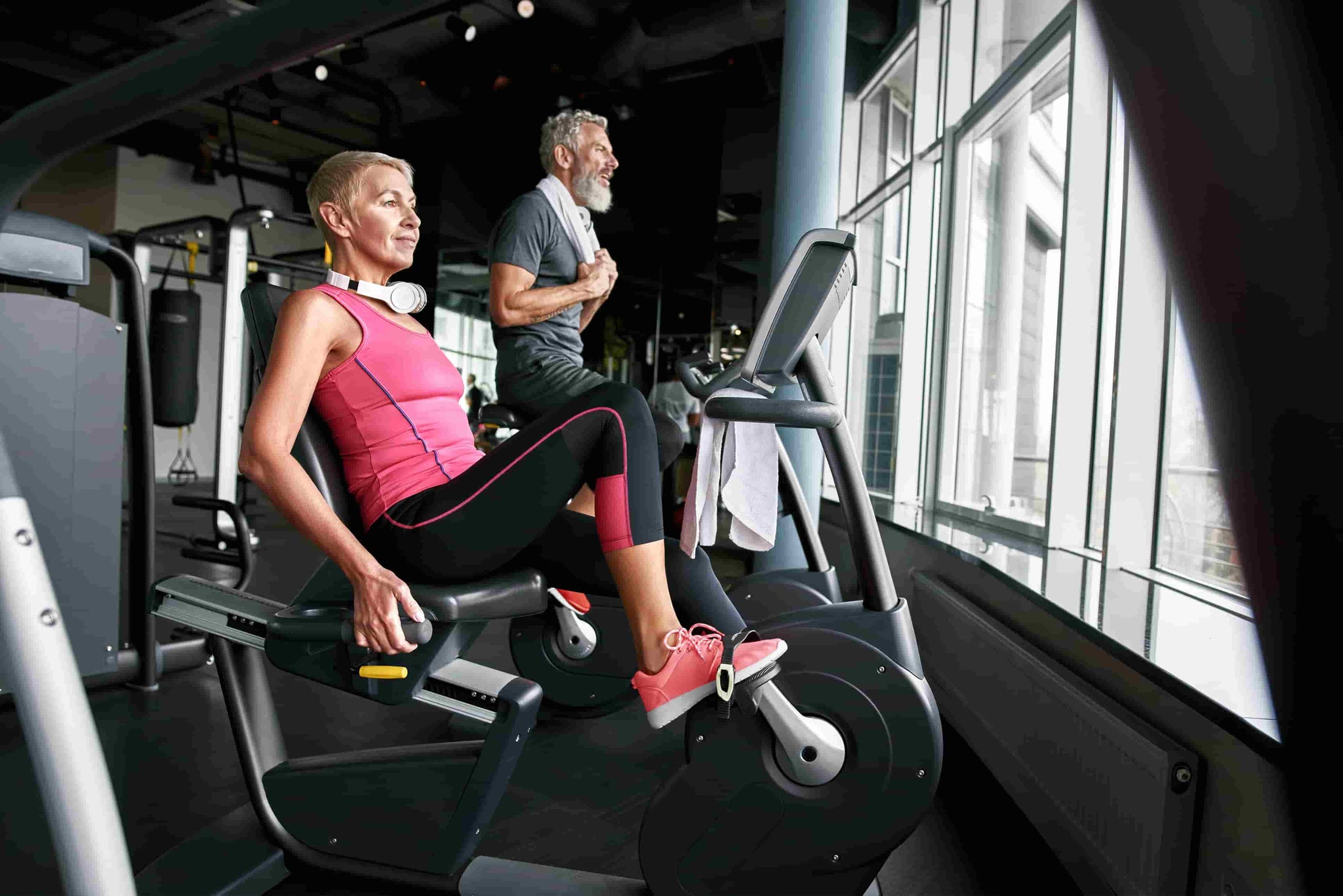Recumbent Bike Workout Plan: Tailored Routines for Every Fitness Level
Written by: Vanswe Fitness
Published on: April 29, 2025. Last updated: May 08, 2025

A recumbent bike is one of the most accessible and versatile pieces of fitness equipment available today. With its supportive backrest and reclined position, it offers a low-impact yet highly effective cardiovascular workout suitable for users of all ages and fitness levels. But to get the most from your ride, it's essential to follow a workout plan that matches your current ability and goals.
In this guide, we’ll break down recumbent bike workout plans customized for beginners, intermediate users, seniors, rehab patients, and individuals aiming to lose weight.
Who Should Follow a Recumbent Bike Workout Plan?
Anyone looking for a safe, low-impact way to improve fitness can benefit from a recumbent bike workout plan. It’s ideal for beginners, seniors, people in rehabilitation, and those aiming to lose weight or build endurance.
- Beginners – Learn proper form and build endurance.
- Intermediate Users – Break plateaus and increase challenge.
- Seniors – Stay active with safe, joint-friendly movement.
- Rehabilitation Patients – Support injury recovery with gentle motion.
- Weight Loss Seekers – Burn fat through structured routines.
Let’s dive into each group’s needs and recommended plans.
Source: According to the American Heart Association [1], moderate-intensity aerobic activity, like recumbent biking, is effective and safe for adults of all ages.
Recumbent Bike Workout Plan for Beginners
Beginners should start with short, low-resistance sessions—about 15 to 30 minutes, 3 to 5 times a week. This builds cardiovascular endurance while keeping the workout joint-friendly and easy to stick with.
Related Article: Beginner Recumbent Bike Plan
The above beginner-focused guide covers:
- Proper bike setup and posture
- Week-by-week progression from 15 to 30 minutes
- Tips to build consistency and avoid common mistakes
If you're a beginner, we believe this article will be helpful to you.
Source: The ACSM [2] recommends beginners engage in 20–30 minute cardio sessions 3–5 times per week to build cardiovascular endurance safely.
Recumbent Bike Workout Plan for Intermediate Users
Intermediate users should aim for 30–40 minute sessions, 3 to 5 times per week, with moderate to high intensity. Incorporating interval training and tracking heart rate can help improve endurance and boost calorie burn.
This stage builds on beginner progress by increasing duration, adding resistance, and introducing heart rate zones or cadence targets. It's ideal for breaking plateaus and reaching new fitness goals.
Goals: Improve cardiovascular fitness and muscular endurance.
Weekly Plan:
| Week | Duration | Intensity | Focus |
|---|---|---|---|
| 1–2 | 30 mins x 3-5 times | Moderate | Endurance + Intervals |
| 3–4 | 40 mins x 3-5 times | Mid-High | Tempo + Zone 3 heart rate |
Pro Tip: Track cadence (RPM) and heart rate. Aim to ride in aerobic zones for longer durations and include short surges for interval benefits.
Recumbent Bike Workout Plan for Seniors

A typical recumbent bike workout plan for seniors includes 10 to 20 minutes of low-resistance pedaling, 3 to 5 times per week, helping to maintain mobility, improve circulation, and support heart health.
This plan focuses on gentle movement, proper back support, and a steady pace—making it ideal for older adults looking to stay active without straining their knees or hips.
Goals: Maintain mobility, improve circulation, and stay safe.
Recommended Routine:
- Warm-Up: 5 minutes of light pedaling
- Main: 10–20 minutes at a comfortable pace, 3–5x/week
- Cool-Down: 5 minutes of easy riding + stretching (calves, hamstrings, back)
Here is some things Vanswe Fitness thinks you should know:
- Keep resistance low to moderate
- Always sit with your back fully supported
- Stop if you feel dizzy or short of breath
Source: According to the National Institute on Aging [3], older adults should aim for 150 minutes of moderate activity per week, including low-impact options like recumbent biking.
Rehabilitation-Focused Recumbent Bike Workout Plan
Many physical therapists recommend recumbent bikes for patients recovering from knee surgery, spinal issues, or chronic pain. Start with 10–15 minutes at low resistance, either daily or every other day, based on your condition.
Goals: Restore mobility, promote circulation, and prevent muscle atrophy.
Weekly Plan:
| Week | Duration | Frequency | Resistance |
|---|---|---|---|
| 1–2 | 10 mins | Daily | Low |
| 3–4 | 15–20 mins | Every other day | Low to Medium |
Important:
- Coordinate with your physician or PT
- Avoid high resistance or sudden speed changes
- Focus on smooth, pain-free motion
Source: A randomized clinical trial published in JAMA Network Open [4] found that structured outpatient rehabilitation, which can include low-impact cycling like recumbent biking, significantly improved functional mobility after total knee arthroplasty.
Recumbent Bike Workout Plan for Weight Loss
To lose weight with a recumbent bike, aim for 25–45 minutes of moderate to high-intensity cycling, 3 to 5 times per week. Alternate between steady-state rides and interval sessions to burn more calories and boost fat loss.
This weight loss plan combines longer endurance rides with short bursts of intensity, helping you stay in the fat-burning heart rate zone while protecting your joints. Pairing the workouts with a healthy diet accelerates results.
Weekly Plan
| Day | Duration | Intensity | Notes |
|---|---|---|---|
| Mon | 30 mins | Moderate | Maintain a steady pace |
| Wed | 25 mins | Intervals | 5 rounds of 2-min fast / 1-min slow |
| Fri | 45 mins | Low-Moderate | Fat-burning zone endurance ride |
Calories Burned Estimate:
- Moderate ride (30 mins): ~210–280 calories
- Interval session (25 mins): ~250–350 calories
Tip: Combine with strength training and nutrition adjustments for faster results.
Related Tool: Recumbent Bike Calories Burned Calculator
Tips for Sticking to Your Recumbent Bike Plan
To stay consistent, treat your workouts like appointments, keep them fun with music or podcasts, and track your progress weekly. Setting small, achievable goals helps build lasting habits.
- Schedule your rides like appointments
- Listen to music or podcasts
- Track your progress using apps
- Set weekly mini-goals
- Reward yourself for reaching milestones
Conclusion
following a recumbent bike workout plan tailored to your fitness level can improve endurance, support weight loss, and protect your joints. Whether you're a beginner, senior, or recovering from injury, consistency and structure are key to seeing results.
Start with a routine that matches your needs, stay consistent, and gradually progress in duration and intensity. With the right plan, a recumbent bike becomes a safe, effective tool for reaching your health and fitness goals.
References
- American Heart Association. Recommendations for Physical Activity in Adults. .
- Garber, C. E., Blissmer, B., Deschenes, M. R., Franklin, B. A., Lamonte, M. J., Lee, I. M., Nieman, D. C., Swain, D. P., & American College of Sports Medicine (2011). American College of Sports Medicine position stand. Quantity and quality of exercise for developing and maintaining cardiorespiratory, musculoskeletal, and neuromotor fitness in apparently healthy adults: guidance for prescribing exercise. Medicine and science in sports and exercise, 43(7), 1334–1359.
- National Institute on Aging. Exercise and Physical Activity for Older Adults.
- Hsieh, C. J., DeJong, G., Vita, M., Zeymo, A., & Desale, S. (2020). Effect of Outpatient Rehabilitation on Functional Mobility After Single Total Knee Arthroplasty: A Randomized Clinical Trial. JAMA network open, 3(9), e2016571.
Latest Articles






